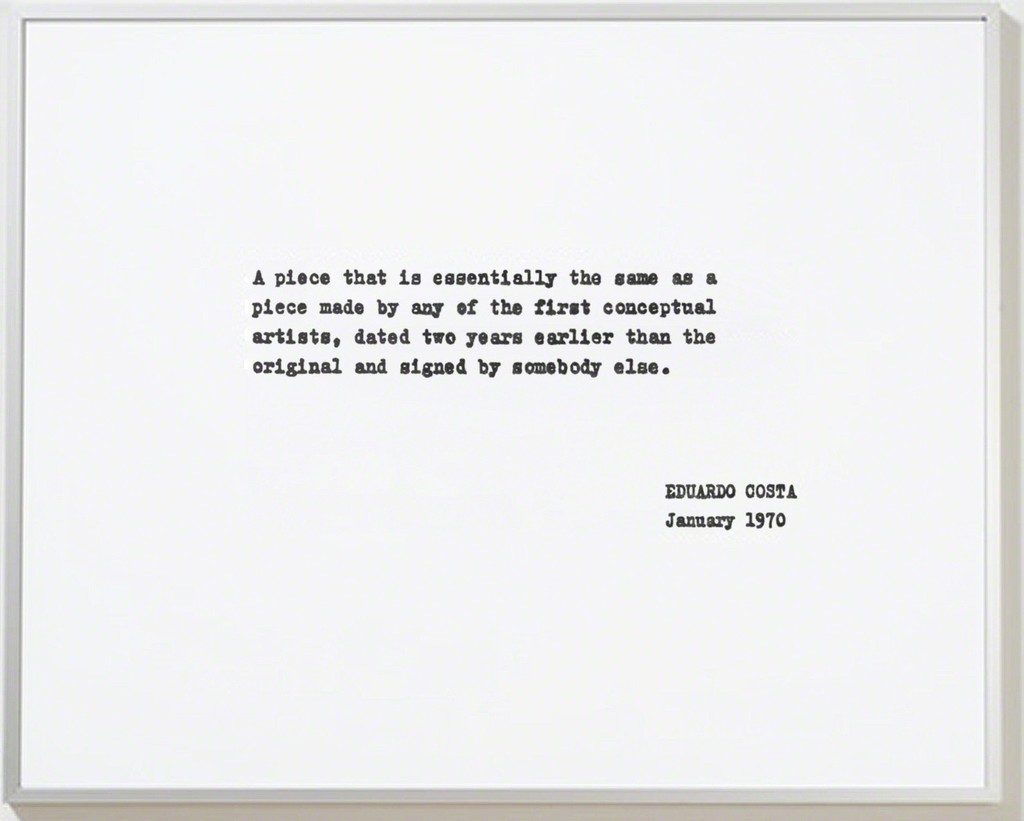Eduardo Costa (1940, Buenos Aires) is an argentine conceptual artist who lived twenty five years in the United States and four in Brazil. He studied Literature and Art History at the University of Buenos Aires. At the early sixties he became interested in new art formas as Happenings and Media Art as a new field for art experimentation. His practice was focused maingly on collaborative projects. In 1966 Costa created, along with Roberto Jacoby and Raúl Escari, the First Mass-Media Art work and wrote A Media Art (Manifesto). That same year presented with Jacoby, Poema Ilustrado and later performed with Risuelo and Jacoby as well, the First hearing of works created for Oral Language at the Torcuato Di Tella Institute (Buenos Aires) and wrote the Manifesto for an Oral Literature. At the end of the 1960s, he traveled to New York and there he got in touch with artists and poets such as John Perreault, Vito Acconci, Scott Gordon and Hannah Weiner, among others. With Leo Castelli’s support, Costa presented the Fashion Fiction I, in 1966, published in Vogue magazine in 1968. In 1969, along with John Perreault, he edited “Tape Poems” that included works by the editors as well as from Vito Acconci, Scott Burton, Dan Graham, Anne Waldman, among other artists. That same year he created Names of friends. A poem for the Deaf-mute and organized with Weiner and Perreault the Fashion show poetry event -that combined fashion and poetry- at the Center for Inter American Relations in New York. He later organized Street Works I-IV with John Perreault and Marjorie Strider in the streets of New York in which artists, poets and critics where involved. In 1970 he participated in the exhibition/catalogue curated by Athena T. Spear at the Allen Art Museum (Ohio) with “A piece that is..”. In 1971, he returned to Buenos Aires. In 1977 he participated in the tribute to Marcel Duchamp, at Arte Nuevo gallery with his Duchamp / Costa Wheel. In 1978 he settled in Río De Janeiro and participated in the project Esquenta pro Carnaval, together with Hélio Oiticica (1979-1980). During his stay in Brazil, he participated in projects organized by Hélio Oiticica, Lygia Pape, Antonio Manuel, Lygia Clark, and others avant-garde artists. In 1981 Costa returned to New York and continued his work with the Fashion Fiction series. In 1983 he created his first Electric Paintings and Electric Installations. Since 1994, he developed his Volumetric Painting -name given by Carter Ratcli!, a series of works that put in crisis painting as a traditional discipline. In 1995 he exhibited them at the Elga Wimmer gallery. A major retrospective of his works was held at the Tamayo Museum in Mexico in 2017. He has also exhibited at the New Museum, New York; Victoria and Albert Museum, London; Reina Sofía Museum, Madrid; MIT List Visual Arts Center, Mass .; Miami Art Museum, Miami; Jumex Foundation, Mexico City; Vienna Secession, Vienna, Austria; Lisson Gallery, London; Museum of Modern Art, Rio de Janeiro; Museum of Modern Art, Sao Paulo; Museum of Modern Art, Buenos Aires; National Museum of Fine Arts, BA; Malba- Fundación Costantini, BA; Tamayo Museum, Mexico and others. His work has been discussed in Art in America, Art Forum, and in the main books on conceptual art: A. Alberro, MIT, 1999; P. Osborne, Phaedon, 2002; Mari Carmen Ramírez and Héctor Olea, Yale/Houston Museum of Art, 2004; Inés. Katzenstein, MoMA, New York, 2004, Luis Pérez- Oramas and others, San Antonio Museum of Art, 2004; Luis Camnitzer, University of Texas, 2007, among others. His works belong to important public collections, such as: The Museum of Modern Art, New York; The Metropolitan Museum, New York; Blanton Museum of Art, Texas; Museum of Modern Art, Río de Janeiro; Modern Museum of Art, Buenos Aires; Museum of Fine Arts, Buenos Aires; Jumex Collection, Mexico DF; Mercantil Bank in Caracas, among others. He lives and works in Buenos Aires.


 Costa Eduardo
Costa Eduardo